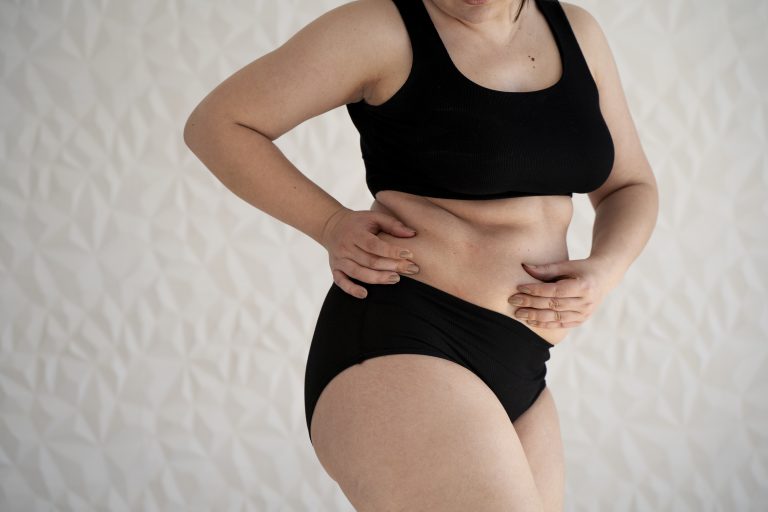Let’s get real for a minute…
If you’re in your 40s or 50s and noticing that no matter how “good” you eat or how much you exercise, your belly seems to have a mind of its own — you’re not imagining it. And you’re definitely not failing.
You’re simply not being told the truth.
The truth is, not all belly fat is created equal.
Especially during perimenopause, when hormones are on a rollercoaster, stress is high, and your body is screaming for a different kind of support.
Instead of blaming yourself (or your willpower), it’s time to understand the real reason that belly weight is clinging on — and what it’s trying to tell you.
Here are the 6 most common types of perimenopausal belly fat and how to spot them in your own body.
1. Adrenal Belly (a.k.a. The “I’m Fine” Belly)
This belly shows up when you’ve been running on cortisol for years. You’re doing all the things, holding everyone together, and your body has slipped into survival mode.
What it looks like:
- High, firm belly under the ribs
- Cravings for sugar or salty snacks
- Waking up between 2–4am
- Exhausted but wired
This belly type is crying out for nervous system support — not another bootcamp!
2. Insulin-Resistant Belly (The “But I Eat So Well!” Belly)
Even if you’re eating “clean,” …. if your blood sugar is swinging and insulin sensitivity is dropping (which it naturally does in perimenopause), fat starts to cling to your midsection like glue.
What it looks like:
- Soft, bloated, puffy belly
- Intense carb or sugar cravings
- Afternoon energy crashes
- May have skin tags or dark patches
The key here? Focus on blood sugar balance over calorie counting.

3. Estrogen-Dominant Belly (The Hormonal Rollercoaster Belly)
Even though estrogen fluctuates and drops in perimenopause, it can still be too high in relation to progesterone — especially if detox pathways are sluggish or xenoestrogens are sneaking in.
What it looks like:
- Lower region belly weight and bloating
- Mood swings, breast tenderness
- Heavy or painful periods
- History of PMS or fibroids
Now is the time to show your liver and gut some love, and boot those hormone-disrupting chemicals out.
4. Cortisol-Storing Belly (The “I Swear I’m Doing Everything Right” Belly)
This belly often overlaps with adrenal belly but comes from long-term, unrelenting stress. Even if you’re eating healthy, your body stays in “protect mode.”
What it looks like:
- Fat around the belly and nowhere else
- Sluggish digestion, brain fog
- You feel puffy, heavy, tired, and anxious
- The stressed body resists weight loss — even when you’re “doing it all right”
This isn’t about more discipline — It’s about your body’s ability to regulate and recover from stress.
5. Thyroid Belly (The “I’m So Tired I Could Cry” Belly)
Perimenopause can overwhelm the thyroid and nudge it into an underactive state — especially when stress, autoimmunity, or nutrient deficiencies are involved.
What it looks like:
- Puffiness over the whole body
- Hair thinning, nails breaking
- Cold hands/feet
- Depression, low motivation
- Belly fat (and back fat) that won’t shift, no matter what
For recovery, look towards metabolic support and re-boot, not more restriction.
6. Inflammation Belly (The “Why Am I So Bloated?” Belly)
This one’s less about fat and more about inflammatory bloat. Gut issues, food sensitivities, immune imbalance — they are all involved in inflammation.
What it looks like:
- Belly that expands as the day goes on
- Feels tender, swollen, or distended
- Skin issues, joint pain, brain fog
- Reacts strongly to gluten, dairy, or stress
Conquer inflammation starting with gut health — it’s asking for healing, not dieting.
So… Which Belly Are You Wearing?
Understanding your type is the first step to working with your body — instead of punishing it.
- Imagine what happens when you finally stop guessing…
- When you stop blaming yourself for “not trying hard enough”…
- When you know exactly how to support your unique hormonal body.
That’s when the real transformation begins.
Want to Find Your Belly Type?
I’ve created a quick, printable self-assessment quiz to help you figure out your type — and what to do next. It’s free, fun, and wildly illuminating.
And if you’d like personalised support, you can book a Naturopathic Consultation with me — where we’ll look under the hood and build a tailored plan to get your spark back.
Teressa
Naturopath + Biochemist
Ready to kick start Gut Health? Book a Call!

This is how gut microbes can influence weight!
Probiotics can help you gain weight or lose weight by interacting with our genetics, food and metabolism.
And yes, I did say lose or gain weight……..
Firstly, let me explain that the trillions of microbes in the gut need to be varied, meaning that there should be a large variety of species. There are many different species (or breeds) of microbes, and they all have their place in aiding health — the more variety and balance, the better health results.
Back to the weight loss or weight gain issue….
Do you eat yogurt and berries for breakfast? Thinking that it’s helping you lose weight?
Well, Lactobacillus acidophilus (like the species found in yoghurt) has been connected to weight gain.
I am not saying throw your yoghurt and berries in the bin. Instead, I am suggesting looking at the overall picture. If Lactobacillus acidophilus is the predominant micro-organism of the gut, then weight gain can result.
It is about the variety of species of gut microbes. Imagine if we only have trained german shepherd guard dogs in the world. It may be a safe world, but I am sure that other breeds may be more suitable as a family pet.
While Lactobacillus acidophilus is associated with weight gain, other Lactobacillus species correlate with weight loss.
Species like Lactobacillus plantarum, Lactobacillus gasseri, and Bifidobacteria animalis have been found to support weight loss.
Want to lose weight?
Look at your gut flora to support your goal.
Tests can be performed to identify the predominant species of the gut, and specific species can be utilised to support weight changes.
Want more information about your gut health?
Or want to look at all the factors contributing to weight gain, I’d love to be able to help.







